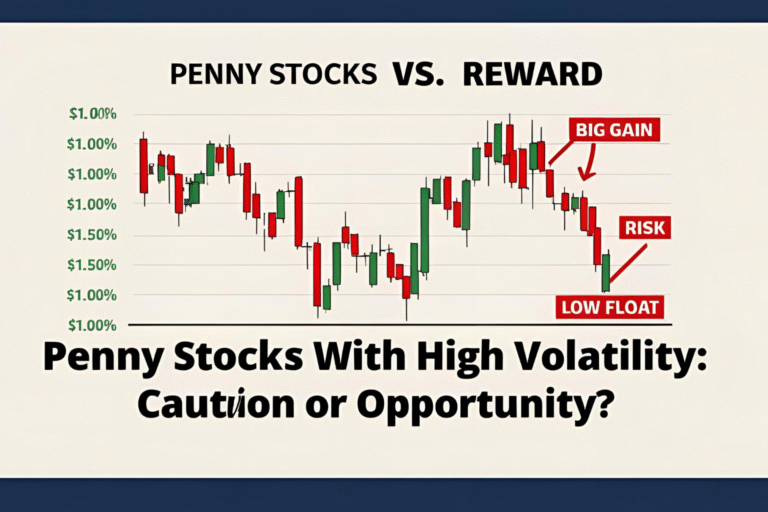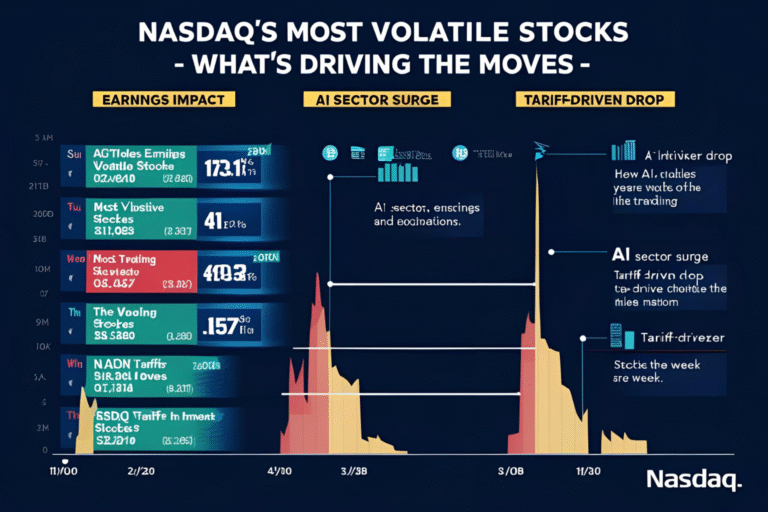Monthly Breakdown: Most Volatile Stocks in the S&P 500
Each month, the S&P 500—home to some of the largest U.S. companies—hosts stocks that move far more than the index itself. These outliers represent high-volatility opportunities for traders seeking momentum, breakout setups, or aggressive swing trades.
In this blog, we present a monthly breakdown of the most volatile stocks in the S&P 500, based on average price ranges, volume spikes, and percentage moves.
Why Monitor Monthly Volatility?
Volatility is not random. It often clusters around:
- Earnings reports
- Sector rotations
- Economic data releases
- Market-wide sentiment shifts
Tracking monthly volatility helps:
- Identify stocks with strong momentum
- Spot reversal opportunities
- Build watchlists for active trades
Top 10 Most Volatile S&P 500 Stocks – May 2025 (Sample List)
| Ticker | Sector | Avg Daily % Range | Monthly % Move | Volatility Insight |
|---|---|---|---|---|
| NVDA | Tech | 6.8% | +14.2% | AI-fueled rally with strong earnings |
| TSLA | Auto/EV | 5.4% | –11.5% | High volume selloff after guidance miss |
| META | Communication | 4.6% | +9.1% | Volatility driven by earnings + upgrades |
| AMD | Semiconductors | 5.1% | +13.8% | Breakout from multi-month consolidation |
| MRNA | Healthcare | 4.9% | –8.6% | Biotech swings on FDA and trial data |
| F | Automotive | 3.7% | +5.2% | Earnings surprise + EV sector momentum |
| NCLH | Travel | 4.2% | +10.4% | Recovery rally on improved bookings data |
| CRM | Software | 3.9% | –6.3% | Earnings volatility + sector weakness |
| NFLX | Media | 4.4% | +7.7% | Post-earnings breakout and analyst action |
| BA | Industrials | 3.5% | –4.1% | Mixed news flow and market risk pressure |
Note: Data is illustrative. Use platforms like Finviz, TradingView, or Thinkorswim to generate live monthly volatility filters.
How We Measured Monthly Volatility
We used the following criteria:
- Average daily price range (high–low %)
- 30-day implied volatility (IV)
- Trading volume vs. monthly average
- Monthly % price change
Volatility is most actionable when paired with:
- Volume confirmation
- Catalysts (news, earnings, analyst actions)
- Technical levels (breakouts, trendlines)
Tools to Track Monthly Volatile S&P 500 Stocks
- TradingView Screener – Set filters for % change, ATR, volume, and sectors
- Finviz Elite – Use volatility and beta filters + performance charts
- Yahoo Finance – View monthly % change and historical price movement
- Market Chameleon – For IV ranks and earnings-driven volatility tracking
How to Use This List for Trading
- Build Watchlists
- Focus on 5–10 stocks with wide ranges and volume
- Look for continuation patterns or breakout setups
- Pair With Technical Analysis
- Use moving averages, VWAP, and RSI to time entries
- Watch for bull/bear flags, consolidation zones, or range breaks
- Avoid Traps
- Skip low-volume or extended names without confirmation
- Use stop-loss orders on all trades involving volatile setups
FAQs
Is high volatility in S&P 500 stocks rare?
No. While the index is relatively stable, individual stocks often show double-digit monthly moves.
What’s a good minimum volatility filter?
Look for stocks with a 3%+ average daily range and above-average volume.
Are these stocks suitable for beginners?
Volatile S&P stocks are generally more stable than penny stocks, but traders should still use defined risk.
Can I use options on volatile S&P 500 stocks?
Yes. These stocks often have deep options chains and high IV, making them ideal for both directional and non-directional strategies.
How often should I update this list?
Monthly for swing trading. Weekly if you’re actively day trading volatile names.




